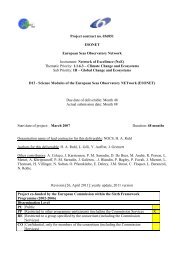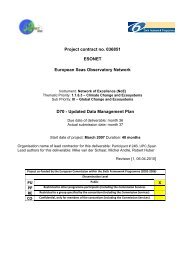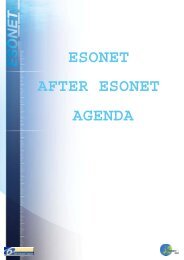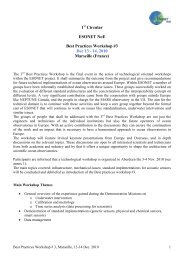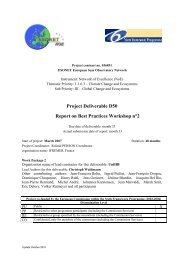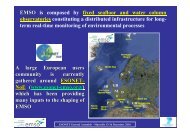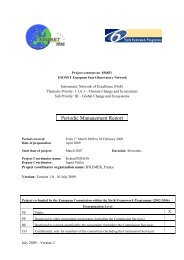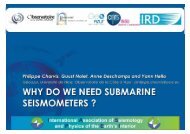The Monterey Accelerated Research System - ESONET NoE
The Monterey Accelerated Research System - ESONET NoE
The Monterey Accelerated Research System - ESONET NoE
Create successful ePaper yourself
Turn your PDF publications into a flip-book with our unique Google optimized e-Paper software.
MBARI Cable Laying<br />
Toolsled<br />
<strong>The</strong> <strong>Monterey</strong> <strong>Accelerated</strong> <strong>Research</strong><br />
<strong>System</strong> • 9 kW of power for science<br />
• 8X 100 Mbit/sec Ethernet ports<br />
• Precision time distribution<br />
– ~5 uSec<br />
• Deep water - 890 meters<br />
• Accessible - 2 hrs from MBARI<br />
• Extended geographic coverage<br />
with extension cables<br />
• Extensive shoreside support<br />
– Staging, ships, ROVs, expertise<br />
• A comprehensive workflow<br />
process – from proposal through<br />
development, test, deployment,<br />
and data management
What is<br />
MARS?<br />
MARS is a single "science node" 891 meters<br />
below the surface of <strong>Monterey</strong> Bay. <strong>The</strong> MARS<br />
science node has eight ports. Each of the eight<br />
ports is equipped with an underwater mateable<br />
connector. <strong>The</strong> science node is connected to<br />
the shore through 52-km of subsea telecom<br />
cable that carries data and power.
On November 10, 2008,<br />
the ROV Ventana<br />
connected the main<br />
MARS telecom cable’s<br />
power and fiber optic<br />
links to the MARS<br />
electronics node<br />
<strong>The</strong> yellow portion houses<br />
the MARS electronics in an<br />
ROV removable section.<br />
<strong>The</strong> MARS trawl-resistant<br />
frame.<br />
ROV access door is open<br />
underwater connectors<br />
inside
Science and instrument testing<br />
schedule for MARS<br />
1. November 10, 2008 Sensors project CTD PI: D. Edgington, MBARI<br />
2. December 9, 2008 FOCE (Free Ocean CO2 Experiment) PI: P. Brewer, MBARI<br />
3. January 21, 2009 Eye-in-the-Sea PI: E. Widder, ORCA<br />
4. February 26, 2009 MOBB, <strong>Monterey</strong> Ocean Bottom Broadband PI: B. Romanowicz, UC<br />
Berkley<br />
5. February 27, 2009 Monitoring pelagic biomass fluxes in <strong>Monterey</strong> Bay PI: J.K. Horn,<br />
UW<br />
6. August 6, 2009 Benthic Rover – PI: K. Smith, MBARI<br />
7. October 1, 2009 Deep ESP- Environmental Sample Processor PI: C. Scholin, MBARI<br />
8. October 28, 2009 Acoustic Communications Base Station- PI: Lee Freitag, WHOI<br />
9. November 4, 2009 Bottom pressure recorder (BPR) and a precision tiltmeter, PI:<br />
Bill Chadwick, NOAA
While over-fishing was the ocean crisis<br />
realized in the 20 th century, ocean<br />
acidification will be the crisis of the 21 st<br />
century.<br />
What will be the ecology of the acidic<br />
ocean? How will the food chain be<br />
altered? What management practices will<br />
need to be changed?<br />
FOCE<br />
Free Ocean CO2<br />
Experiment<br />
Dr. Peter Brewer<br />
http://www.mbari.org/mars/<br />
general/foce.html<br />
Deployed Dec 9, 2008
FOCE prior to unfolding on the bottom
Eye-in-the-<br />
Sea<br />
Dr. Edith Widder<br />
http://www.oceanrecon.org/re<br />
search.htm<br />
Deployed January 21, 2009<br />
• Objective is to collect unobtrusive video<br />
observations of deep sea animal behavior using<br />
red lights, no thrusters<br />
• Connected to significant education and<br />
outreach program
MOBB<br />
<strong>Monterey</strong> Ocean Bottom Broadband<br />
Deployed February 26, 2009<br />
Seismic<br />
Observatory<br />
• Only continuously<br />
recording<br />
seismometer west of<br />
the San Andreas<br />
fault system<br />
• Hookup to the<br />
MARS cable will<br />
provide data in real<br />
time, avoiding use of<br />
lithium batteries
EK60 Echosounder Specifications<br />
Bottom<br />
~35 m<br />
Surface<br />
• Echosounder: Simrad EK60; 38 kHz; 7 o beam<br />
• custom mounted in Benthos sphere<br />
• real-time monitoring and display via internet<br />
Fish diel vertical migration<br />
17:00 10:00
Echosounder Specifications<br />
• Simrad EK60; 38 kHz; 7 o splitbeam<br />
• custom mounted in Benthos sphere<br />
• real-time command/monitoring from shore
Benthic<br />
Rover<br />
Dr. Ken Smith, MBARI<br />
http://www.mbari.org/ma<br />
rs/general/rover.html<br />
To be deployed August 6,<br />
2009<br />
• Typically used in autonomous mode, connected to<br />
MARS for testing and refinement<br />
• Performs a time series of measurements at the<br />
sediment interface, thus avoiding numerous<br />
separate expeditions and ROV dives
Environmental Sample Processor : Detection of invertebrate larvae, pennate diatoms<br />
and groups of bacteria on a single array: Chris Scholin, MBARI<br />
To be deployed Nov 4, 2009<br />
chemistry control and<br />
intensity standards<br />
- 125 ml whole water sample<br />
- 0.45μm filter<br />
- 2ml homogenate<br />
“all eukaryotes”<br />
junk
Sensors and data availability<br />
• Sensors CTD: http://ssdspub.mbari.org:8080/mars/marsCTD.jsp.<br />
• Eye in the Sea (EITS): http://www.mbari.org/mars/general/eits/livefeed.html.<br />
• MOBB (<strong>Monterey</strong> Ocean Bottom Broadband):<br />
http://www.berkeley.edu/news/media/releases/2009/03/18_mobb.shtml.<br />
• EK 60: http://acoustics.washington.edu/DEIMOS/deimos_data.php<br />
• FOCE: http://www.mbari.org/mars/general/foce.html<br />
• Benthic Rover: http://www.mbari.org/mars/general/rover.html<br />
• Deep Environmental Sample Processor (ESP):<br />
http://www.mbari.org/mars/general/deep_esp.html



